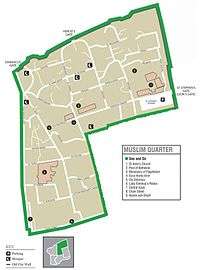Muslim Quarter
The Muslim Quarter (Arabic: حارة المسلمين Harat al-Muslimin; Hebrew: הרובע המוסלמי Ha-Rovah ha-Muslemi) is one of the four quarters of the ancient, walled Old City of Jerusalem. It covers 31 hectares (76 acres) of the northeastern sector of the Old City.[1] The quarter is the largest and most populous and extends from the Lions' Gate in the east, along the northern wall of the Temple Mount in the south, to the Damascus Gate—Western Wall route in the west. The Via Dolorosa starts in the quarter.[2]

The population of the Muslim Quarter is 22,000.[2]
History
The Muslim quarter had a mixed population of Jews, Muslims and Christians until the 1929 Palestine riots.[3] Some 60 Jewish families now live in the Muslim Quarter. Yeshivat Ateret Yerushalayim is the largest yeshiva.[4]
In 2007, the Israeli government started funding the construction of The Flowers Gate development plan, the first Jewish settlement inside the Muslim Quarter since 1967. It would include 20 apartments and a synagogue.[5]
Landmarks
Jewish landmarks include the Kotel Katan or Little Western Wall, and the Western Wall Tunnels, which run below the neighborhood along the Western Wall. There are many Roman and Crusader remains in the quarter. The first seven Stations of the Cross on Via Dolorosa (Way of the Cross) are located there.[6]
See also
- Ateret Cohanim
- Bab Al Huta
- Birket Israel
- Church of the Flagellation
- Ohel Yitzchak Synagogue
- Pool of Bethesda
- St Anne's Church
- Via Dolorosa
- Zedekiah's Cave
References
- ↑ The Holy Land, pg. 29.(This area excludes the Temple Mount which measures 35 acres)
- 1 2 Muslim Quarter of the "Old City" section of Jerusalem
- ↑ "Israel cements ownership of Jewish Quarter in Jerusalem's Old City". Haaretz. 11 March 2008.
- ↑ The Yeshiva's History - Retrieved 18 September 2014
- ↑ Wilson, Scott (11 February 2007). "Jewish Inroads in Muslim Quarter". The Washington Post.
- ↑ Jerusalem - The Old City
External links
![]() Media related to Muslim Quarter at Wikimedia Commons
Media related to Muslim Quarter at Wikimedia Commons
Overviews
Coordinates: 31°46′51″N 35°13′57″E / 31.78083°N 35.23250°E
